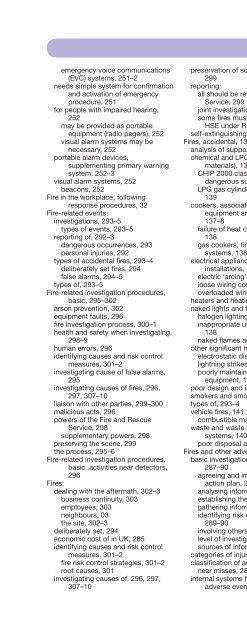Introduction to Fire Safety Management
Introduction to Fire Safety Management
Introduction to Fire Safety Management
Create successful ePaper yourself
Turn your PDF publications into a flip-book with our unique Google optimized e-Paper software.
emergency voice communications<br />
(EVC) systems, 251–2<br />
needs simple system for confi rmation<br />
and activation of emergency<br />
procedure, 251<br />
for people with impaired hearing,<br />
252<br />
may be provided as portable<br />
equipment (radio pagers), 252<br />
visual alarm systems may be<br />
necessary, 252<br />
portable alarm devices,<br />
supplementing primary warning<br />
system, 252–3<br />
visual alarm systems, 252<br />
beacons, 252<br />
<strong>Fire</strong> in the workplace, following<br />
response procedures, 32<br />
<strong>Fire</strong>-related events:<br />
investigations, 293–5<br />
types of events, 293–5<br />
reporting of, 292–3<br />
dangerous occurrences, 293<br />
personal injuries, 292<br />
types of accidental fi res, 293–4<br />
deliberately set fi res, 294<br />
false alarms, 294–5<br />
types of, 293–5<br />
<strong>Fire</strong>-related investigation procedures,<br />
basic, 295–302<br />
arson prevention, 302<br />
equipment faults, 296<br />
fi re investigation process, 300–1<br />
health and safety when investigating,<br />
298–9<br />
human errors, 296<br />
identifying causes and risk control<br />
measures, 301–2<br />
investigating cause of false alarms,<br />
295<br />
investigating causes of fi res, 296,<br />
297, 307–10<br />
liaison with other parties, 299–300<br />
malicious acts, 296<br />
powers of the <strong>Fire</strong> and Rescue<br />
Service, 298<br />
supplementary powers, 298<br />
preserving the scene, 299<br />
the process, 295–6<br />
<strong>Fire</strong>-related investigation procedures,<br />
basic .activities near detec<strong>to</strong>rs,<br />
296<br />
<strong>Fire</strong>s:<br />
dealing with the aftermath, 302–3<br />
business continuity, 303<br />
employees, 303<br />
neighbours, 03<br />
the site, 302–3<br />
deliberately set, 294<br />
economic cost of in UK, 285<br />
identifying causes and risk control<br />
measures, 301–2<br />
fi re risk control strategies, 301–2<br />
root causes, 301<br />
investigating causes of, 296, 297,<br />
307–10<br />
preservation of scene undisturbed,<br />
299<br />
reporting:<br />
all should be reported <strong>to</strong> local <strong>Fire</strong><br />
Service, 299<br />
joint investigations, 300<br />
some fi res must be reported <strong>to</strong><br />
HSE under RIDDOR, 299<br />
self-extinguishing, 298<br />
<strong>Fire</strong>s, accidental, 136–41<br />
analysis of supposed causes, 293–4<br />
chemical and LPG (hazardous<br />
materials), 139<br />
CHIP 2000 classifi cations of<br />
dangerous substances, 139<br />
LPG gas cylinders a serious risk,<br />
139<br />
cookers, associated cooking<br />
equipment and installations,<br />
137–8<br />
failure of heat controlling devices,<br />
138<br />
gas cookers, fi res caused by faulty<br />
systems, 138<br />
electrical appliances and<br />
installations, 136–7<br />
electric ‘arcing’ (or sparking), 137<br />
loose wiring connections, 137<br />
overloaded wiring, 136–7<br />
heaters and heating systems, 138<br />
naked lights and fl ames, 138<br />
halogen lighting, 138<br />
inappropriate use of lighting units,<br />
138<br />
naked fl ames and human error, 138<br />
other signifi cant hazards, 140–1<br />
electrostatic discharges, 140<br />
lightning strikes, 140<br />
poorly maintained mechanical<br />
equipment, 140<br />
poor design and installation, 138<br />
smokers and smokers’ materials, 140<br />
types of, 293–4<br />
vehicle fi res, 141<br />
combustible materials in, 141<br />
waste and waste management<br />
systems, 140<br />
poor disposal arrangements, 140<br />
<strong>Fire</strong>s and other adverse events, 284–91<br />
basic investigation procedures,<br />
287–90<br />
agreeing and implementing an<br />
action plan, 290<br />
analysing information, 289<br />
establishing the cause, 288<br />
gathering information, 288–9<br />
identifying risk control measures,<br />
289–90<br />
involving others, 288<br />
level of investigation, 287–8<br />
sources of information, 289<br />
categories of injury causation, 286–7<br />
classifi cation of adverse events, 286<br />
near misses, 286<br />
internal systems for managing<br />
adverse event data, 291<br />
Index<br />
reasons for investigation, 285<br />
role and function of investigation,<br />
285–6<br />
policy requirements, 285–6<br />
<strong>Fire</strong>s and road traffi c accidents, 353<br />
<strong>Fire</strong>water run-off, 320–1<br />
generation and containment, 321<br />
Flame propagation, most common<br />
mode defl agration, 127<br />
Flammable liquids, 139, 165<br />
external s<strong>to</strong>rage, 151, 152<br />
management of works involving,<br />
156<br />
Flammable materials/substances,<br />
126<br />
effective management of prior <strong>to</strong><br />
starting operations, 156<br />
fi re risk in construction and<br />
maintenance, 143<br />
inadequate arrangements for safe<br />
waste disposal, 143<br />
lack of competency in use, 143<br />
provision of Materials <strong>Safety</strong> Data<br />
Sheets (MSDS), 120–1<br />
Flashover, defi ned, 172<br />
FPA (<strong>Fire</strong> Protection Association), 26<br />
data from the insurance industry, 92<br />
FRSA (<strong>Fire</strong> and Rescue Services Act<br />
(2004)), 17, 298, 352–5<br />
Fuel, defi nition, 116<br />
Fuel hazard, aerosol containers:<br />
immediate action, 334<br />
limited control measures, 334–5<br />
need <strong>to</strong> reduce number of aerosols<br />
s<strong>to</strong>res, 335<br />
Fuel/air cloud:<br />
confi ned:<br />
accelerating fl ame front, 128<br />
weak ignition source, slow burning<br />
defl agration, 128<br />
unconfi ned and unobstructed, fl ame<br />
velocity, 128<br />
Gas Appliances (<strong>Safety</strong>) Regulations<br />
(1992), 378–9<br />
Gas explosions, 127, 130, 131<br />
Gas <strong>Safety</strong> (Installation and Use)<br />
Regulations (1998), 379<br />
Gas systems/appliances, likely <strong>to</strong><br />
become ‘fail safe’, 149<br />
Glass, use of in buildings, 180–1<br />
glazing system requirements for<br />
gasses vary, 180–1<br />
insulating glass, 180<br />
non-insulating glass, 180<br />
Halogen lighting, 138, 150, 162<br />
Halon gases in fl ooding systems:<br />
replacement, HFC-227ea fi re<br />
suppression agent, 221<br />
use discontinued, 221<br />
Harm, defi ned, 84<br />
Hazard:<br />
defi ned, 2, 84<br />
presents risk, causing accident/injury,<br />
ill health, damage or loss, 90<br />
411

















